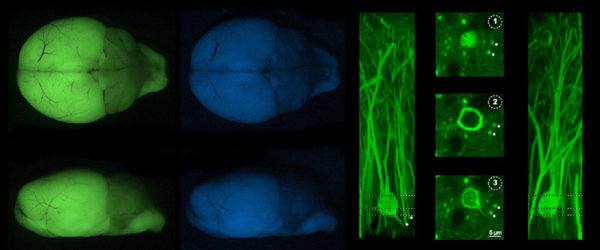
Tools for Bio-Imaging
Probing the brain with fluorescent proteins
An array of new technologies is needed in neuroscience to gain a full dynamic picture of how individual brain cells and complex neuronal circuits interact during behavior and respond to drug action in health and disease. This significance of this need is illustrated, among others, by the ambitious and large “BRAIN Initiative” launched by former US President Obama and the National Institute of Health (NIH) with the aim to promote the development of new technologies for neuroscience. The new endeavors include improved monitoring of neuronal activity across space and time and the assessment of the modulation these circuits undergo during behavior by advancing recording techniques, instrumentation, and optical sensors and actuators.
Protein-based tools are at the core of many of the above strategies as they endow a high degree of specificity. This allows highlighting designated types of neurons and their subcellular structures, and permits their implantation deeply into living brains. Proteins are used as sensors to monitor activity or biochemistry of neurons, to control or block action potential firing of neurons, or to manipulate circuits on longer time scales by pharmaco-genetics. As such, proteins typically exploit the talents evolved in nature, but they rarely come to application in their native form. In order to obtain a protein variant that performs highly in a real physiological experiment, a certain amount of “evolution” is generally necessary: Often, many iterative cycles of improvements and adaptations are necessary, domains of different origins may need to be recombined, and several engineering and design strategies may need to be tried and validated.
Our research focuses on the development of protein biosensors to study neuronal activity and biochemistry. We aim to take a comprehensive multidisciplinary approach that combines biophysical and structural studies of the protein constituents of biosensors with latest molecular biology techniques, new screening approaches, testing in physiological settings and finally, use of the probes in physiology.